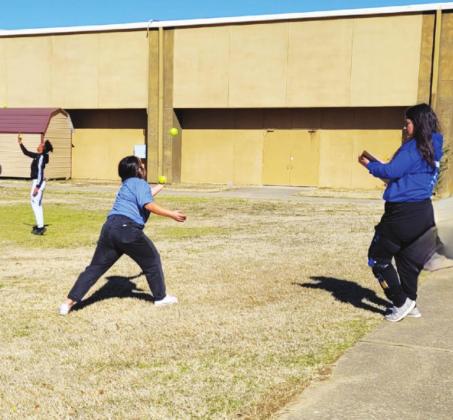Freshman are getting into the action at Sulphur Springs High School taking CTE, or Career and Technical Education, courses. One such class is Principles of Exercise Science and Wellness, an introductory course for freshmen and sophomores, where students are learning abut physical, mental and emotional health.
The course description shares that students will learn to understand diet and exercise, as well as techniques to help patients recover from injury, illness and disease. Students will also be learning about introductory health science topics including employability skills, lifespan development and ethical and legal standards.
Wednesday afternoon, students went outside to practice juggling tennis balls with their non-dominant hand, part of a ten week project where they record each other’s progress, in order to experience learning a skill for the first time while correlating physical knowledge back to academic knowledge.
Casey Pederson, the Principles of Exercise Science and Wellness teacher, shared that this project helps students remember what it was like to learn a skill for the first time such as walking, in order to relate to how a physical therapy patient feels relearning to walk or how student feels when they learn dribble a ball for the first time.
Caitlin Foster and Ty Holt, two freshman currently enrolled in the class, shared some of the topics they had covered in class such as the ethics of cheating in sports, concussions, steroid use and the impacts they have on an athlete’s health and career.
Another topic covered is the impact a person’s environment, economic status, and other personal barriers have an affect on their physical activity as well as the effects of a sedentary lifestyle.
The students shared that they had learned about the division of genders in sports and how women were treated unequally.
Foster shared that it had been interesting to learn that women didn’t have the same opportunities in sports as men.
Pederson reminded Foster and Holt of a video they had watched of the Boston Marathon in 1967 when Kathrine Switzer was attacked by the race director Jock Semple who tried to throw her out while she was running because she was a woman.
Pederson shared that students will be learning about motor development later in the year.
In their senior year students who are 18 years old and have their high school diploma are eligible to take the Personal Trainer certification test online.
Pederson shared that in the Kinesiology course students will learn more about rehabilitation and injury prevention, motor skills, the functions of bones and muscles, and how to teach movements.
Earlier in the year, students created a game with modifications to the rules such as turning four square into nine square or laying Ultimate Football with a kickball.
Students were challenged to either make the game easier or harder while also teaching a skill.
Pederson shared that in college she did a project where she created an activity or game for elementary age students which also included parts of the curriculum or STAAR test questions.
Students presented a research project where they each chose a career within the field of Exercise Science and Wellness such as a Physical Education teacher, Coach, Physical Therapist, Athletic Trainer, Nutritionist or recreational therapist and shared the education requirements, outlook or demand for the job, salary or earning potential, and helpful high school courses.
According the TEA, the focus of Principles of Exercise Science and Wellness is to provide students with a solid foundation in the topics of health and wellness as well as increasing their interest in the various careers available in the field.


